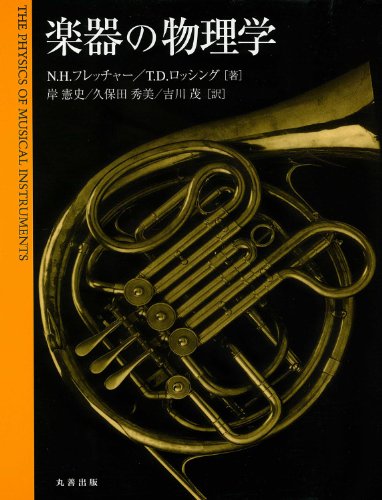73 0 0 0 音楽の専門家を目指す人達への音響教育 (<小特集>音響教育の現状と展望)
- 著者
- 吉川 茂 大串 健吾 山田 真司 岩宮 眞一郎
- 出版者
- 一般社団法人 日本音響学会
- 雑誌
- 日本音響学会誌 (ISSN:03694232)
- 巻号頁・発行日
- vol.55, no.3, pp.199-206, 1999
- 参考文献数
- 18
- 被引用文献数
- 1
ガウディによれば、サクラダファミリア大聖堂の全体は1つの巨大な楽器として構想されていた。鐘の音楽と協会における礼拝との間での音響的なバランスをとるべく鐘楼の下部構造は一種のマフラー(消音器)になっている。生誕の門の左側(外から見て)の塔(ツインタワーの形をしている)に着目して、そのほぼ下半分の基本構造を1/25縮尺模型で再現し、上部に音源(「鐘」の代用)を置いて音の伝搬特性について実験した。音源スピーカーから14〜96kHzの広帯域信号を入力し、音響レベルを測定したところ、身廊部では約35dBの減衰があり、隣の塔ではさらに約10dBの減衰が見られた。上部構造からの放射に適合する鐘は細長い形をしたチューブラベル・タイプである。ピッチを決める主要な振動モードは(1,4)であり、両端では円形断面を保ちながら左右の5本(G5,A5,B5,C6,D6にチューニングされている)のベルに関する実験から確認した。ただし、ピッチがいくつかの部分音の寄与によって決まるのではなく、たった1つの振動スペクトルによって決まるので複数本のチューブラベルを組み合わせるときの効果は期待できない。生誕の門のファッサードにおける彫刻群「天使の合唱隊」などから予想される音楽的シーンは「復活祭の鐘の音と合唱の声」とか「エオルスの琴の音を伴奏とする妖精たちの合唱」などである。一方、塔、チューブラベル、螺旋階段などは完結性を意味するポジティブな円環であるとともに「樹木」のように閉ざされることのない「有魂」の「器官」を象徴している。サグラダファミリア大聖堂は鐘および合唱の音楽と合体することによって初めて「母なる自然の創造力と養育力(ゲーテの言う自然の治癒力)」を体現でき、「ガウディの聖堂」にふさわしくなると推測できる。
5 0 0 0 OA ホルンのストップ奏法に関する数値シミュレーションと管壁振動測定
- 著者
- 鰕原 孝康 吉川 茂
- 雑誌
- 研究報告 音楽情報科学(MUS)
- 巻号頁・発行日
- vol.2011-MUS-89, no.3, pp.1-5, 2011-02-04
ホルンにおけるストップ奏法とは、右手の手のひらでベルをふさいで強く吹奏することで、鋭い金属的な音色を作る奏法である。この奏法において楽器の入力インピーダンスが変化することがこれまで研究されてきたが、その金属的な音色の原因については考えられてこなかった。本研究ではその原因として、(1) 伝達関数、(2) 唇の非線形振動と管内衝撃波、(3) 管壁振動の 3 つの可能性について検討し、数値シミュレーションと測定によって管壁振動がその音色の原因であることが明らかになった。
4 0 0 0 OA 利き手・利き目と体力・運動能力との関係
- 著者
- 中雄 勇 堤 実 吉川 茂
- 雑誌
- 阪南論集 人文・自然科学編 = Journal of Hannan University Humanities & natural science
- 巻号頁・発行日
- vol.28, no.1, pp.1-9, 1992-06
4 0 0 0 OA セクシュアリティに関する羞恥についての心理学的研究
- 著者
- 吉川 茂
- 雑誌
- 阪南論集.人文自然科学編
- 巻号頁・発行日
- vol.55, no.1, pp.63-76, 2019-10
4 0 0 0 OA 心理学からみた「だてマスク」の着用
- 著者
- 吉川 茂
- 雑誌
- 阪南論集.人文自然科学編
- 巻号頁・発行日
- vol.53, no.1, pp.35-40, 2017-10
3 0 0 0 パイプオルガンの音響学 (<小特集>パイプオルガン)
- 著者
- 吉川 茂
- 出版者
- 一般社団法人日本音響学会
- 雑誌
- 日本音響学会誌 (ISSN:03694232)
- 巻号頁・発行日
- vol.47, no.11, pp.834-843, 1991-11-01
- 被引用文献数
- 7
2 0 0 0 OA 金管楽器の物理モデルにおける反射関数の考察
- 著者
- 山上 憲 吉川 茂
- 雑誌
- 情報処理学会研究報告音楽情報科学(MUS)
- 巻号頁・発行日
- vol.2003, no.16(2002-MUS-049), pp.43-48, 2003-02-21
これまでの管楽器のシミュレーション研究では,楽器の気柱自体の細かい特性についての考察はあまりなされていない。本研究では楽器内部の段差に注目することで,楽器気柱の応答の違いがどのように影響するかを検討する。トランペットの管内形状において,マウスピースと楽器の接続部分に段差あり/なしの2つのモデルの反射関数を求め,それを元に物理モデルで発音シミュレーションを行なった。シミュレーションは吹奏圧を一定にする場合と,徐々に上げていく場合の2通りを行なった。その結果,管内の段差の有無による反射関数の違いは,定常音の状態では,違いがほとんど見られないが,音の立ち上がりについては,多少ではあるが違いがあることが確認された。
2 0 0 0 OA 利き手に関する基礎的研究 ―利き手と利き目の関連性―
- 著者
- 中雄 勇 堤 実 吉川 茂
- 雑誌
- 阪南論集 人文・自然科学編 = Journal of Hannan University Humanities & natural science
- 巻号頁・発行日
- vol.32, no.3, pp.1-14, 1997-01
2 0 0 0 OA 旅行者新奇性に関する心理学的考察
- 著者
- 吉川茂 よしかわしげる
- 雑誌
- 阪南論集. 人文・自然科学編
- 巻号頁・発行日
- vol.38, no.2, pp.41-49, 2003-03
2 0 0 0 楽器における自励発振機構の解析 (電気音響特集号)
- 著者
- 吉川 茂 実吉 純一
- 出版者
- 一般社団法人日本音響学会
- 雑誌
- 日本音響学会誌 (ISSN:03694232)
- 巻号頁・発行日
- vol.37, no.11, pp.p543-550, 1981-11
- 被引用文献数
- 3
2 0 0 0 エアリード楽器における流速分布と擾乱波動の成長率について
- 著者
- 有元 慶太 吉川 茂
- 出版者
- 一般社団法人情報処理学会
- 雑誌
- 情報処理学会研究報告音楽情報科学(MUS) (ISSN:09196072)
- 巻号頁・発行日
- vol.2001, no.16, pp.5-11, 2001-02-22
エアリード楽器において、尺八、フルートを仮定した"short"とパイプオルガンやリコーダーを仮定した"long"の二つのフルー形状について流速分布を測定した。理論上は"long"の場合、ジェットはフルー内部ではPoiseuille分布、フルーから出た後はb=4h/5(ジェットの半幅をb,フルーの高さを2hとする)のBickley分布に従い、"short"の場合はフルー内部ではtop-hat分布、フルーから出た後はb=3h/2のBickley分布に従う。実験結果は、(a)"long"の場合、低速域(10?20m/s)ではb=4h/5のBickley分布に従う。(b)"short"の場合は20?50m/sでフルーからの距離Xが8mmの場合ジェットの流速分布はb=3h/2のBickley分布に従う。(c)"short"の場合は低速域(10?20m/s)ではフルーからの距離xが2mm<x<8mmの範囲ではジェットの流速分布はn=3のNolleに従う。これらより、結論として線形化した不安定性理論に基づくと、低速域ではジェットの擾乱波動の成長率は"short"よりも"long"の方が大きいと考えられる。It is empirically known that the geometry of the flue channel and the flue exit significantly affects the tone color in air-jet instruments. A precise correlation between this flue geometry and the resulting jet velocity profile was investigated experimentally. Two kinds of flue geometry, "long" and "short", are used. Theoretically, a "long" flue, which is a model of organ pipes or recorders, yields the Poiseuille profile for the channnel flow and the Bickley profile (with half width b=4h/5, where 2h defines the jet thickness at the flue exit) for the subsequent jet flow. A "short" flue, which is a model of the flute or shakuhachi, yields the top-hat profile for the channel flow and the Bickley profile(with b=3h/2) for the subsequent jet flow. Experimental results show the following: (a) A "long" flue gives the theoretical Bickley jet for 10m/s < V_<max> < 20m/s and for 2mm < x(distance from the flue) < 8mm. (b) A "short" flue gives the theoretical Bickley profile jet for 20m/s < V_<max> < 50m/s and for x=8mm, (c) A "short" flue gives the empirical Nolle profile for 10m/s < V_<max> < 20m/s and for 2mm < x < 8mm. Since the Bickley profile yields larger amplification factor of the jet-wave disturbance than the Nolle profile, we may consider that a "long" flue yields larger amplification factor than a "short" flue in the range of 10m/s < V_<max> < 20m/x and for 2mm < x < 8mm.
2 0 0 0 正倉院尺八吹奏時の歌口端補正長さの推定
- 著者
- 吉川 茂
- 出版者
- 情報処理学会
- 雑誌
- 研究報告 音楽情報科学(MUS) (ISSN:21862583)
- 巻号頁・発行日
- vol.2011, no.1, pp.1-5, 2011-02-04
東大寺の正倉院に保存されている唐より伝来した尺八 (正倉院尺八) の音響的特性を歌口端および指孔開孔端での補正長さに着目して検討した。ベースとした定量的データは昭和期の調査における各運指における発音周波数の測定記録である。正倉院北倉の竹製尺八の寸法図面を基に、数値計算用モデルを設定し、歌口における入力アドミッタンスのピーク値より発音周波数を計算できるようにした。この計算周波数と吹鳴調査における発音周波数が一致するとして歌口端補正長さを推定した。また、この発音周波数が与える波長から、指孔開孔列がもたらす補正長さも求めた。これらの結果より、2 つの補正長さの周波数 (運指) 依存性、オクターブ・バランス、クロス・フィンガリングと音律異常、尺八とベーム・フルートなどについて考察した。One of the Shousouin Shakuhachis, that were transmitted from the T'ang dynasty and have been preserved in the Shousouin of the Toudaiji, is acoustically investigated focusing on the length corrections at the embouchure hole and the open-hole lattice. Quantitative data as the research basis are the records on the sounding frequencies that were measured at the investigation in the Shouwa period. Based on a geometry figure of the bamboo-made shakuhachi in the north warehouse, a physical model is constructed to calculate the sounding frequency from the maximum magnitude of the input admittance at the embouchure hole. The length correction at the embouchure hole is estimated by assuming that this calculated frequency corresponds to the blown frequency measured at the Shouwa investigation. Also, another length correction at the open-hole lattice is derived from the wavelength of the blown sound. These numerical results conducted some discussions on the frequency (fingering) dependence of the length corrections, the octave balance, the cross fingerings and the associated intonation anomaly, the Japanese shakuhachi and the western flute.
1 0 0 0 OA エアリード楽器の物理と音色 (<小特集>楽器の物理と音色)
- 著者
- 吉川 茂
- 出版者
- 一般社団法人 日本音響学会
- 雑誌
- 日本音響学会誌 (ISSN:03694232)
- 巻号頁・発行日
- vol.49, no.3, pp.193-202, 1993-03-01 (Released:2017-06-02)
- 参考文献数
- 58
1 0 0 0 OA 利き手に関する基礎的研究 ―利き手と握力について―
- 著者
- 中雄 勇 堤 実 吉川 茂
- 雑誌
- 阪南論集 人文・自然科学編 = Journal of Hannan University Humanities & natural science
- 巻号頁・発行日
- vol.29, no.3, pp.15-23, 1994-01
1 0 0 0 OA 正倉院尺八吹奏時の歌口端補正長さの推定
- 著者
- 吉川 茂
- 雑誌
- 研究報告 音楽情報科学(MUS)
- 巻号頁・発行日
- vol.2011-MUS-89, no.1, pp.1-5, 2011-02-04
東大寺の正倉院に保存されている唐より伝来した尺八 (正倉院尺八) の音響的特性を歌口端および指孔開孔端での補正長さに着目して検討した。ベースとした定量的データは昭和期の調査における各運指における発音周波数の測定記録である。正倉院北倉の竹製尺八の寸法図面を基に、数値計算用モデルを設定し、歌口における入力アドミッタンスのピーク値より発音周波数を計算できるようにした。この計算周波数と吹鳴調査における発音周波数が一致するとして歌口端補正長さを推定した。また、この発音周波数が与える波長から、指孔開孔列がもたらす補正長さも求めた。これらの結果より、2 つの補正長さの周波数 (運指) 依存性、オクターブ・バランス、クロス・フィンガリングと音律異常、尺八とベーム・フルートなどについて考察した。
1 0 0 0 OA サワリ機構をもつ弦楽器モデルにおける撥弦振動に関する実験的考察-初期条件の影響について-
- 著者
- 千田 崇文 吉川 茂
- 雑誌
- 研究報告 音楽情報科学(MUS)
- 巻号頁・発行日
- vol.2011-MUS-89, no.2, pp.1-4, 2011-02-04
本研究では 2 つの異なる初期条件: “up-plucking” と “down-plucking” が与えられた際のサワリ機構との接触を伴う撥弦振動を高速度ビデオカメラを用いて可視化した。その結果、振動周期や高周波の形成過程に関して初期条件が弦振動に与える影響が確認された。
1 0 0 0 OA 乱数生成における心理学的要因(1)
- 著者
- 吉川 茂
- 雑誌
- 阪南論集 人文・自然科学編 = Journal of Hannan University Humanities & natural science
- 巻号頁・発行日
- vol.28, no.4, pp.49-56, 1993-03
1 0 0 0 OA 虚無僧尺八の音響学的・社会学的デザインに関する研究
「舞蛟」、「露堂々」など江戸、明治期の虚無僧尺八の名器は「地無し尺八」と呼ばれ、竹管の自然形体をそのままに、節をわずかに残して製管されている。本研究では、第2節(第4孔の少し上に位置する)より上と下では管内形状が有意に異なり、かつ第2節の残し方に独特な特徴のあることが低音域と高音域での響きと音色の差異(多彩さ)をもたらすと推論した。さらに、名器を用いた実演や CD 録音での演奏者や聴衆の印象から、メリカリ奏法での上下への音高変化と運指が現代尺八よりも虚無僧尺八において容易であり、響きと音色の差異を導くと推論された。このような特徴は第2, 3 孔が高めに開けられていることの利点と考えられる。
1 0 0 0 楽器の物理学
- 著者
- N.H. フレッチャー T.D. ロッシング著 岸憲史 久保田秀美 吉川茂訳
- 出版者
- 丸善出版
- 巻号頁・発行日
- 2012

